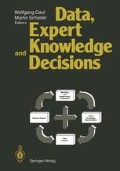Summary
Market researchers examining market segmentation and other aggregation issues can use cluster analysis to form segments of consumers or organizations. When the segments are formed using attitude information or even demographic data, the possibility of measurement error exists.
Previous research (Milligan and Cooper (1985)) had indicated two stopping rules for determining the number of clusters in a data set were superior in the error-free data sets examined. The present research reconfirmed the performance of the pseudo-t and pseudo-F statistics as the best rules in a larger number of replications of error-free data. In addition, the present research examined the performance of stopping rules in low-error and high-error conditions. Low-error would be representative of small measurement error in the data collection instrument or due to respondent error. High error is more severe and can obscure clusters due to the overlapping cluster boundaries.
As one would expect, the ability to recover the true cluster structure deteriorated as more error was introduced into the data. Some stopping rules had differing recovery at different numbers of clusters in the data sets. Two clusters were particularly difficult to recover.
The two best stopping rules for the error-free data were also clearly superior in the error pertubed conditions. Thus, these rules appear to be robust across the conditions tested here.
Access this chapter
Tax calculation will be finalised at checkout
Purchases are for personal use only
Preview
Unable to display preview. Download preview PDF.
References
Baker FB, Hubert LJ (1972) Measuring the Power of Hierarchical Cluster Analysis. Journal of the American Statistical Association 70: 31–38
Beale EML (1969) Cluster Analysis. Scientific Control Systems, London
Calinski RB, Harabasz JA (1974) A Dendrite Method for Cluster Analysis. Communicatons in Statistics 3: 1–27
Cooper MC (1987) The Effect of Measurement Error on Determining the Number of Clusters. Working Paper Series, College of Business, The Ohio State University, Columbus, Ohio
Dalrymple-Alford EC (1970) The Measurement of Clustering in Free Recall. Psychological Bulletin 75: 32–34
Davies DL, Bouldin DWA (1979) A Cluster Seperation Measure. IEEE Transactions on Pattern Analysis and Machine Intelligence 1: 224–227
Duda RO, Hart PE (1973) Pattern Classification and Scene Analysis. Wiley, New York
Frey T, Van Groenewoud HA (1972) A Cluster Analysis of the D-Squared Matrix of White Spruce Stands in Saskatechwan Based on the Maximum-Minimum Principle. Journal of Ecology 60: 873–886
Johnson SC (1967) Hierarchical Clustering Schemes. Psychometrika 32: 241–254
Milligan GW (1985) An Algorithm for Generating Artificial Test Clusters. Psychometrika 501: 123–127
Milligan GW, Cooper MC (1985) An Examination of Procedures for Determining the Number of Clusters in a Data Set. Psychometrika 502: 159–179
Milligan GW, Cooper MC (1988) A Review of Clustering Methodology. Applied Psychological Measurement, in press
Mojena R (1977) Hierarchical Grouping Methods and Stopping Rules: An Evaluation. The Computer Journal 20: 359–363
Punj G, Steward DW (1983) Cluster Analysis in Marketing Research: Review and Suggestions for Application. Journal of Marketing Research 20: 134–148
Rohlf FJ (1974) Methods of Comparing Classifiations. Annual Review of Ecology and Systematics 5: 101–113
Sarle WS (1983) Cubic Clustering Criterion. Technical Report A-108, Cary NC, SAS Institute
Sneath PHA (1977) A Method for Testing the Distinctness of Clusters: A Test of the Disjunction of Two Clusters in Euclidean Space as Measured by Their Overlap. Mathematical Geology 9: 123–143
Author information
Authors and Affiliations
Editor information
Editors and Affiliations
Rights and permissions
Copyright information
© 1988 Springer-Verlag Berlin · Heidelberg
About this paper
Cite this paper
Cooper, M.C., Milligan, G.W. (1988). The Effect of Measurement Error on Determining the Number of Clusters in Cluster Analysis. In: Gaul, W., Schader, M. (eds) Data, Expert Knowledge and Decisions. Springer, Berlin, Heidelberg. https://doi.org/10.1007/978-3-642-73489-2_27
Download citation
DOI: https://doi.org/10.1007/978-3-642-73489-2_27
Publisher Name: Springer, Berlin, Heidelberg
Print ISBN: 978-3-642-73491-5
Online ISBN: 978-3-642-73489-2
eBook Packages: Springer Book Archive

